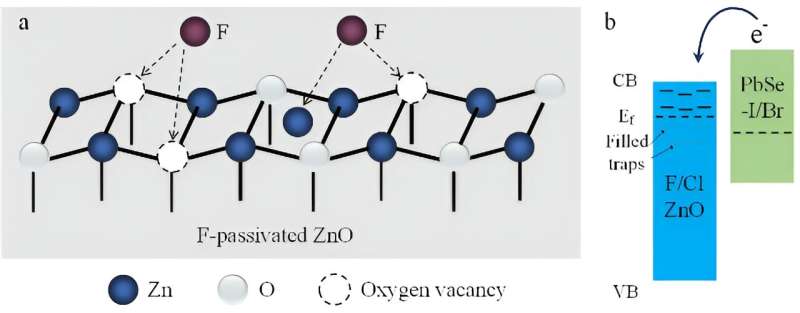This article has been reviewed according to Science X's editorial process and policies. Editors have highlighted the following attributes while ensuring the content's credibility:
fact-checked
proofread
Preparation of F-passivated ZnO for quantum dot photovoltaics

For photovoltaic power generation, pn junction is the core unit. The electric field in the junction can separate and transport the electron and the hole to negative and positive electrodes, respectively. Once the pn junction is connected with a load and exposed to a light ray, it can convert photon power into electrical power and deliver this power to the load. This photovoltaic application has long been used as the power supply for satellites and space vehicles, and also as the power supply for renewable green energy.
As the star materials, Si, GaAs, and perovskite have been widely applied for solar power harvesting. However, the absorption cutoff wavelength of these materials is below 1,100 nm, which limits their photovoltaic applications in infrared photon power. Hence, it is necessary to explore new materials for photovoltaics.
PbSe colloidal quantum dots (CQDs) are promising candidates for photovoltaics because its photoactive range can cover the whole solar spectrum. Thanks to the rapid advances in metal halide ligands and solution phase ligand exchange processes, the efficiency of PbSe CQD solar cells approaches to 11.6%. In view of these developments, further improvement of device performance can focus on the optimization of the electron transport layer (ETL) and the hole transport layer (HTL).
Dr. Jungang He at Wuhan Institute of Technology (WIT) and Prof. Kanghua Li at Huazhong University of Science and Technology (HUST), China, are interested in the improvement of the ETL. They have already reported a record efficiency of PbSe CQD solar cells. In order to further improve the performance with little change the device architecture, they focus on the optimization of F-passivated ZnO. F ions are chosen for defect passivation of ZnO because the radius of F ions is similar to that of oxygen ions. Hence, the trap density of ZnO can be decreased and the device performance can be improved.
The work entitled "Fluoride passivation of ZnO electron transport layers for efficient PbSe colloidal quantum dot photovoltaics" was published in Frontiers of Optoelectronics on Oct. 27, 2023.
More information: Jungang He et al, Fluoride passivation of ZnO electron transport layers for efficient PbSe colloidal quantum dot photovoltaics, Frontiers of Optoelectronics (2023). DOI: 10.1007/s12200-023-00082-3
Provided by Frontiers Journals




















